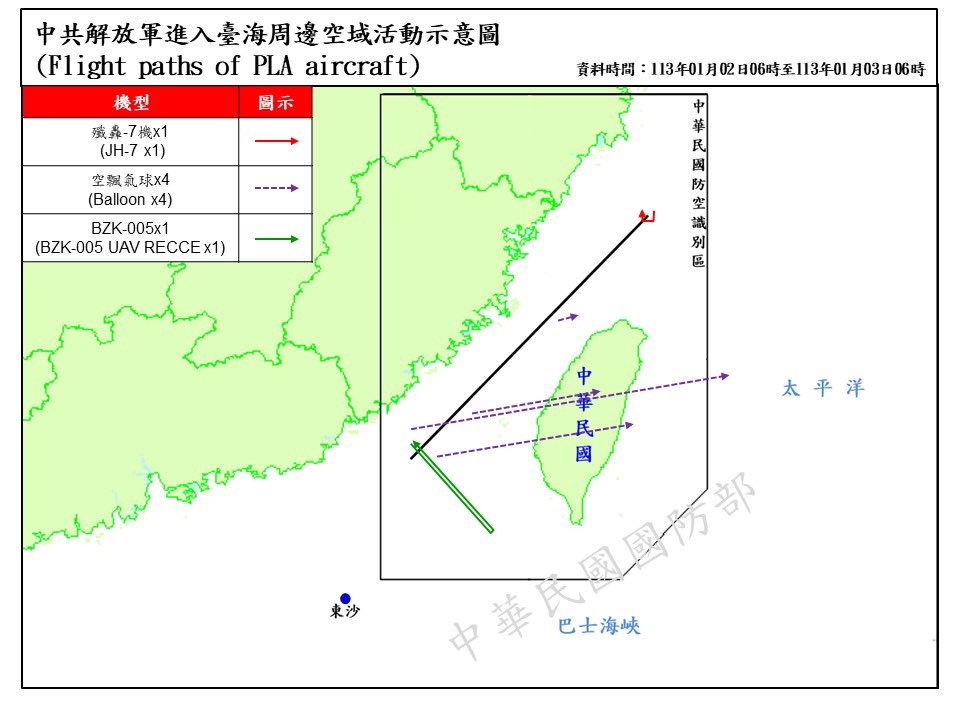
A quartet of Chinese balloons with an unknown purpose have drifted into Taipei’s territorial airspace since Monday. The fights mark a significant escalation from Beijing only a week from Taiwan’s 2024 elections, according to one defense analyst.
While these balloons are not the first to enter Taiwan’s air defense identification zone (ADIZ), with one floating near Taiwan last month, they are the first to violate Taiwanese airspace over the self-governed island. The nature of these balloons is unclear, with Taiwan’s Minister of National Defense claiming that December’s balloon was probably meteorological.
However, Taiwan’s Ministry of National Defense’s PLA activities in the water and airspace, a report released that details Chinese military movements within the ADIZ. In Monday and Tuesday’s releases, the balloons heading, altitude and detection are included, indicating that the Taiwanese military may affiliate these balloons with the Chinese military
The first balloon to enter Taiwanese airspace on Monday evening, drifting in from the Taiwan Strait at an altitude of 30,000 feet. The balloon cut across the island on a northeastern heading. According to the Jan. 3 MND report, the balloon “disappeared” 17 minutes before midnight.
Of the four balloons to enter the ADIZ on Tuesday, three of them cut directly across the center of Taiwan. These balloons were at a substantially lower altitude than Monday’s, with the lowest cruising at 12,000 feet and the highest at 24,000 feet, according to the MND. Moreover, these balloons were drifting into Taiwan’s territorial airspace during the daytime.
Quick update to include altitudes! pic.twitter.com/EyOG80n6Sv
— Ben Lewis 🇺🇦 (@OfficialBen_L) January 3, 2024
The MND graphic also shows one of the balloons seemingly disappearing over central Taiwan, with its track abruptly ending. Of the three balloons that drifted over Taiwan yesterday, only one fully transited Taiwan’s ADIZ and territorial airspace.
While Chinese balloons have previously conducted surveillance activities, as seen in incidents last year over the United States, Taiwan’s Minister of National Defense claimed the balloon spotted in the ADIZ in December was likely for weather monitoring.
Chinese officials also have claimed the balloon shot down last summer off the coast of South Carolina – which had a surveillance package the size of a small bus – was a weather balloon as recently as last week.
In contrast to last month, the balloons this week have not only violated Taiwanese territorial airspace, but also have drifted almost directly over or near major Taiwanese military installations, such as Ching Chuan Kang and Chiayi Air Bases, which host the Republic of China Air Force’s Patriot missile batteries and new F-16V Vipers.
According to independent defense analyst Ben Lewis, these balloons muddle a redline previously set forth by Taipei on the entry of foreign aircraft. However, this may be due to the previous classification of these balloons.
“This represents a significant escalation in the PRC’s coercive actions against Taiwan. The MND’s stated policy is that any military aircraft entering Taiwan’s territorial airspace will be considered a “first strike.” When the balloons first began being included in their daily reports, the MND stated that they assessed the balloons to be meteorological, which explains why they were not shot down, but it is unclear if that assessment can be applied to every balloon tracked,” Lewis said.
Lewis added that the entry of the balloons into Taiwanese territorial airspace proper is the latest in China’s coercive activities, which come a few weeks before the self-governed island’s 2024 elections.
“With less than two weeks from Taiwan’s elections, this is an incredibly provocative move by Beijing. The use of these balloons to violate Taiwan’s territorial airspace, including at altitudes that could impact local civilian air travel, is both incredibly irresponsible and another way Beijing has blurred the lines between civilian and military activities.”





